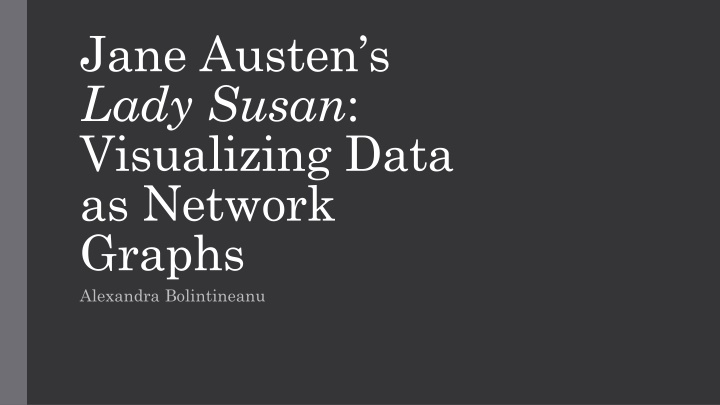
Visualizing Data as Network Graphs in Literature and History
Explore visual representations of data as network graphs in literary works like Jane Austen's "Lady Susan" and historical contexts such as Medieval manuscript ownership, Enlightenment-era correspondence, and more. Learn about modeling relationships through vertices and edges, and discover tools like Cytoscape for visualization.
Download Presentation

Please find below an Image/Link to download the presentation.
The content on the website is provided AS IS for your information and personal use only. It may not be sold, licensed, or shared on other websites without obtaining consent from the author. If you encounter any issues during the download, it is possible that the publisher has removed the file from their server.
You are allowed to download the files provided on this website for personal or commercial use, subject to the condition that they are used lawfully. All files are the property of their respective owners.
The content on the website is provided AS IS for your information and personal use only. It may not be sold, licensed, or shared on other websites without obtaining consent from the author.
E N D
Presentation Transcript
Jane Austens Lady Susan: Visualizing Data as Network Graphs Alexandra Bolintineanu
Modelling Data as Network Network Graph: Network Things: nodes (vertices) Relationships: edges
Les Miserables: Network Graph of Character Interactions Network graph from Gephi (http://gephi.github.io/images/screensh ots/datatable.png). See also Gephi Datasets (https://wiki.gephi.org/index.php/Data sets): Coappearance weighted network of characters in the novel Les Miserables. D. E. Knuth, The Stanford GraphBase: A Platform for Combinatorial Computing, Addison- Wesley, Reading, MA (1993).
Mapping the Republic of Letters Stanford University s Mapping the Republic of Letters (http://republicofletters.stanford.edu/; for network graph, see http://web.stanford.edu/group/toolingu p/rplviz/) visualizes networks of correspondence among Enlightenment-era writers and intellectuals.
Networks of Medieval Manuscript Ownership Mitch Fraas, Charting Former Owners of Penn's Codex Manuscripts, Mapping Books (http://mappingbooks.blogspot.ca/ 2014/01/), January 24, 2014.
Old English Declarations of Unknowing A. Bolintineanu, Beyond the Sun s Setting: Declarations of Unknowing in Old English.
Modelling Jane Austens Lady Susan Data as Network Network Graph: Senders: Things: nodes (vertices) = correspondents letters Relationships: edges Recipients: = letters
Cytoscape Free, open-source visualization software platform Complex networks across disciplines Originated in bioinformatics
Make the Graph Download and install Cytoscape following the software s instructions. (You may have to install Java first. All links are provided on the Cytoscape site: cytoscape.org)
Make the Graph Open Cytoscape On the small screen that pops up, select Start New session With Empty Network
Make the Graph File Import Network File Select your Excel file: tblLadySusanData.xls Remember, characters (i.e. letter senders and recipients) are your nodes (points on the graph); letters are the edges (lines between them). Go to Interaction Definition and enter settings accordingly:: Source Interaction: Column 2, the senders Interaction Type: Default interaction Target: Column 3, the recipients (disable other columns in table below)
View the Graph The resulting graph:
Edit the Graph Make the graph clearer: Click on a node until it turns yellow and drag it about to reposition it - Layout Apply Preferred Layout -
Edit the Graph Make quantitative relationships visible: Tools Network Analyzer Network Analysis Generate Style from Statistics - Say yes - Treat Graph as Directed -
Edge Count: # of edges from and to this node
Network Characteristics 1) Outdegree = # of edges out of this node 2) Indegree = # of edges into this node 3) Centrality: https://en.wikipedia.org/wiki/Centrality
Conclusions? When you view literary data as network graph, what observations and insights do you obtain that a table would not help you make, or not as quickly?
